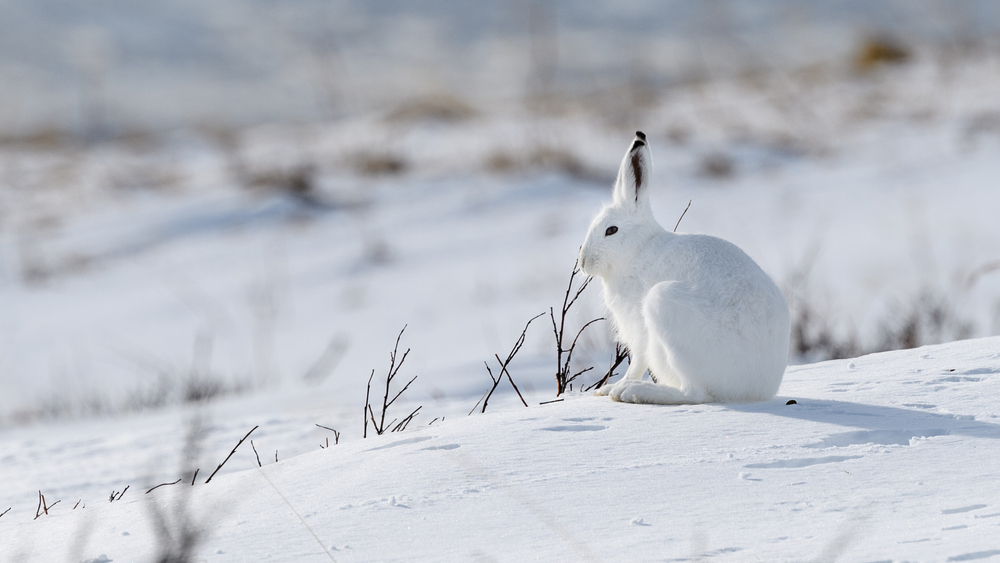The Arctic Hare (Lepus arcticus) is one of the most extreme cold-adapted lagomorphs in the world. While it shares common ancestry with other hares and rabbits, it stands apart due to its size, insulation, survival strategies, and habitat specialization. Below is a comparison of the Arctic Hare with other well-known lagomorphs, including rabbits and hares:
1. Arctic Hare vs. Rabbits (e.g., Eastern Cottontail)
| Trait |
Arctic Hare (Lepus arcticus) |
Cottontail Rabbit (Sylvilagus floridanus) |
| Habitat |
Arctic tundra, rocky hills, snowfields |
Grasslands, forests, suburbs, farmlands |
| Body Size |
Larger: 6–15 lbs (2.7–6.8 kg) |
Smaller: 2–4 lbs (0.9–1.8 kg) |
| Fur |
Thick, seasonal coat (white in winter) |
Shorter, brown-gray coat with white underparts |
| Tail |
Short, white, and not often visible |
Distinct white “cotton ball” tail |
| Burrowing |
Does not dig burrows; rests in snow pits |
Does not burrow but hides in shallow scrapes |
| Reproduction |
1 litter/year, 2–8 young |
3–7 litters/year, 2–8 young per litter |
| Social Behavior |
Solitary or loose winter groups |
Solitary or loosely social |
| Speed |
Very fast (up to 40 mph), long-distance runner |
Fast with zigzag motion (up to 18 mph) |
| Defense Strategy |
Freeze and sprint across snow |
Freeze, then zigzag to cover |
| Adaptation Level |
Highly specialized for cold and scarcity |
Generalist – survives in varied habitats |
Arctic Hares are more robust, solitary, and winter-hardened, while cottontails are smaller, more reproductive, and adaptable to human landscapes.
2. Arctic Hare vs. Other Hares (e.g., Snowshoe Hare, European Hare)
| Trait |
Arctic Hare |
Snowshoe Hare (Lepus americanus) or European Hare (Lepus europaeus)** |
| Climate Adaptation |
Extreme cold (high Arctic only) |
Cold (Snowshoe), temperate (European Hare) |
| Seasonal Color Change |
Yes: white in winter, gray-brown in summer |
Yes (Snowshoe); no (European) |
| Size |
Largest North American hare |
Snowshoe: medium; European: long-legged and slender |
| Ear Length |
Short (to conserve heat) |
Longer in both Snowshoe and European hares |
| Social Behavior |
Mostly solitary |
Snowshoe: solitary; European: more social during mating season |
| Diet |
Arctic shrubs, moss, lichen, woody twigs |
Forest undergrowth (Snowshoe); grasses and crops (European) |
Among hares, the Arctic Hare is the most cold-adapted, with a bulkier build, shorter ears, and greater insulation, while others favor temperate forests or grasslands.
Summary of Unique Arctic Hare Traits:
-
Only hare specialized for life above the treeline year-round
-
Has a stocky body and shorter ears to retain heat
-
Uses snow pits instead of burrows for shelter
-
Lives a slower reproductive cycle due to extreme climate
-
Runs in straight, fast lines instead of zigzagging
-
Capable of forming seasonal aggregations of dozens to hundreds
In short, the Arctic Hare is the high-performance snow survivor of the rabbit and hare family. Compared to other rabbits, it is larger, colder, and calmer; compared to other hares, it is stockier, whiter, and more remote—a true master of Arctic extremes.



































































